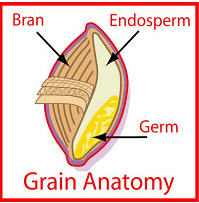What Is whole grain

As the name implies, a grain is considered whole when it has all three parts – bran, endosperm and germ – of the seed intact. Each part of the grain has its own nutritional profile: The outer layer, bran, provides fiber, vitamin B and a small amount of protein; endosperm, a nutritive tissue, packs carbohydrates and protein; germ, the embryo, contains vitamins B and E as well as zinc, magnesium and manganese. In the processing of refined grains such as white flour, some or all of the bran and germ are removed, which strips away most of the grains’ vitamins, minerals and fiber.
Why whole grains rock
Studies show that people who regularly consume whole grains instead of refined grains may have a lower risk of heart disease, stroke, diabetes and certain types of cancers. Incorporating tem into your diet is simple, but be sure to pay close attention to the ingredients list and nutritional facts on all packaged goods to ensure you’re buying quality grains. As a rule of thumb, look for products that list whole grains (whole wheat, whole-grain barley, etc) as one of the first ingredients. This is especially important, since some labels promote their products as having been “made with whole grains”, when in fact they may contain mostly refined material and only a small amount of what you want. (The FDA mandates that a product contain 51% or more whole-grain ingredients to be labeled “whole grain”). To avoid confusion at the supermarket, I recommend buying 100% whole-grain products or purchasing whole grains on their own and adding them to dishes yourself to attain their goodness while adding texture, chewy crunch and a nutty flavor. Plus, the fiber will keep you feeling full for much longer!

